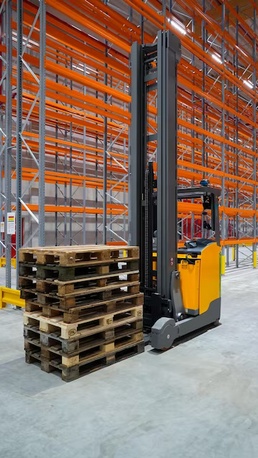Introduction
Pallet racking systems play a pivotal role in optimizing storage and warehouse management. These versatile storage solutions come in various types and configurations, each designed to address different needs and challenges. In this comprehensive guide, we will delve into the world of pallet racking systems, exploring the types, benefits, and diverse applications that have made them an essential component of modern warehousing.
Types of Pallet Racking Systems
Understanding the various types of pallet racking systems is the first step in harnessing their potential. Each type offers unique advantages, making them suitable for different scenarios:
-
Selective Pallet Racking:
- Selective racking is the most common type, providing direct access to each pallet.
- Ideal for operations with a wide range of products or frequent inventory turnover.
- Requires aisles between racks, which can reduce storage density.
-
Drive-In and Drive-Through Racking:
- Drive-in racking eliminates aisles, allowing for high-density storage.
- Suited for products with a long shelf life as it operates on a last-in, first-out (LIFO) system.
- Drive-through racking, on the other hand, offers a first-in, first-out (FIFO) system, making it more suitable for perishable goods.
-
Pallet Flow Racking:
- Utilizes gravity to move pallets, making it ideal for high-density storage and efficient order picking.
- Products are rotated automatically in a first-in, first-out (FIFO) manner, which is beneficial for perishable goods.
-
Pushback Racking:
- Maximizes storage density by allowing multiple pallets to be stored in each lane.
- Provides flexibility for both LIFO and FIFO storage, making it adaptable to various product types.
-
Cantilever Racking:
- Designed for storing long, oversized, or irregularly shaped items like lumber, pipes, or furniture.
- Offers easy access and visibility of stored items.
-
Double Deep Racking:
- Stores two pallets deep, doubling storage capacity compared to selective racking.
- Balances storage density with accessibility.
Benefits of Pallet Racking Systems
Pallet racking systems offer a multitude of benefits that can significantly improve your warehouse operations:
-
Space Optimization:
- Pallet racking systems maximize vertical storage space, making efficient use of available square footage.
- This is particularly important in urban areas where space is at a premium.
-
Enhanced Accessibility:
- Depending on the type of racking system chosen, easy access to stored products can be ensured, streamlining picking and restocking processes.
-
Inventory Control:
- These systems facilitate better inventory management by providing clear organization and visibility of products.
- Tracking and locating items become more manageable, reducing errors and inefficiencies.
-
Cost Efficiency:
- By optimizing space and improving inventory management, pallet racking systems reduce operational costs and enhance overall efficiency.
-
Flexibility and Adaptability:
- The various types of pallet racking systems can be tailored to the specific needs of your products and warehouse layout.
- This adaptability allows for scalability as your business grows.
Applications of Pallet Racking Systems
Pallet racking systems are employed across a wide range of industries and applications. Here are a few examples of how these systems are utilized:
-
Retail and E-commerce:
- Retailers and e-commerce businesses benefit from selective racking, ensuring quick access to products for efficient order fulfillment.
-
Manufacturing:
- In manufacturing, pallet racking systems are used to store raw materials, work-in-progress inventory, and finished products.
-
Pharmaceutical and Healthcare:
- In the pharmaceutical and healthcare industry, precise inventory control is essential. Pallet racking systems aid in organizing and tracking pharmaceuticals, medical equipment, and supplies.
-
Automotive:
- Automotive warehouses store a vast array of components and parts. Pallet racking systems are invaluable for organizing and accessing these items efficiently.
-
Food and Beverage:
- Perishable goods require careful storage. Pallet racking systems, such as drive-in and drive-through racks, are ideal for managing these products.
-
Construction:
- The construction industry uses cantilever racking systems to store lengthy items like pipes, timber, and steel.
-
Third-Party Logistics (3PL):
- Third-party logistics providers utilize pallet racking systems to efficiently manage the diverse inventory of multiple clients.
Conclusion
Pallet racking systems are a cornerstone of modern warehousing, offering a range of benefits that enhance storage efficiency, accessibility, and cost-effectiveness. Understanding the various types of pallet racking systems, their benefits, and their diverse applications is crucial for making informed decisions about implementing them in your warehouse.
By choosing the right racking system and tailoring it to your specific needs, you can unlock the potential for space optimization, efficient inventory control, and overall operational excellence. Regardless of the industry, these systems prove invaluable in managing the ever-evolving demands of the modern warehouse.


No comments yet